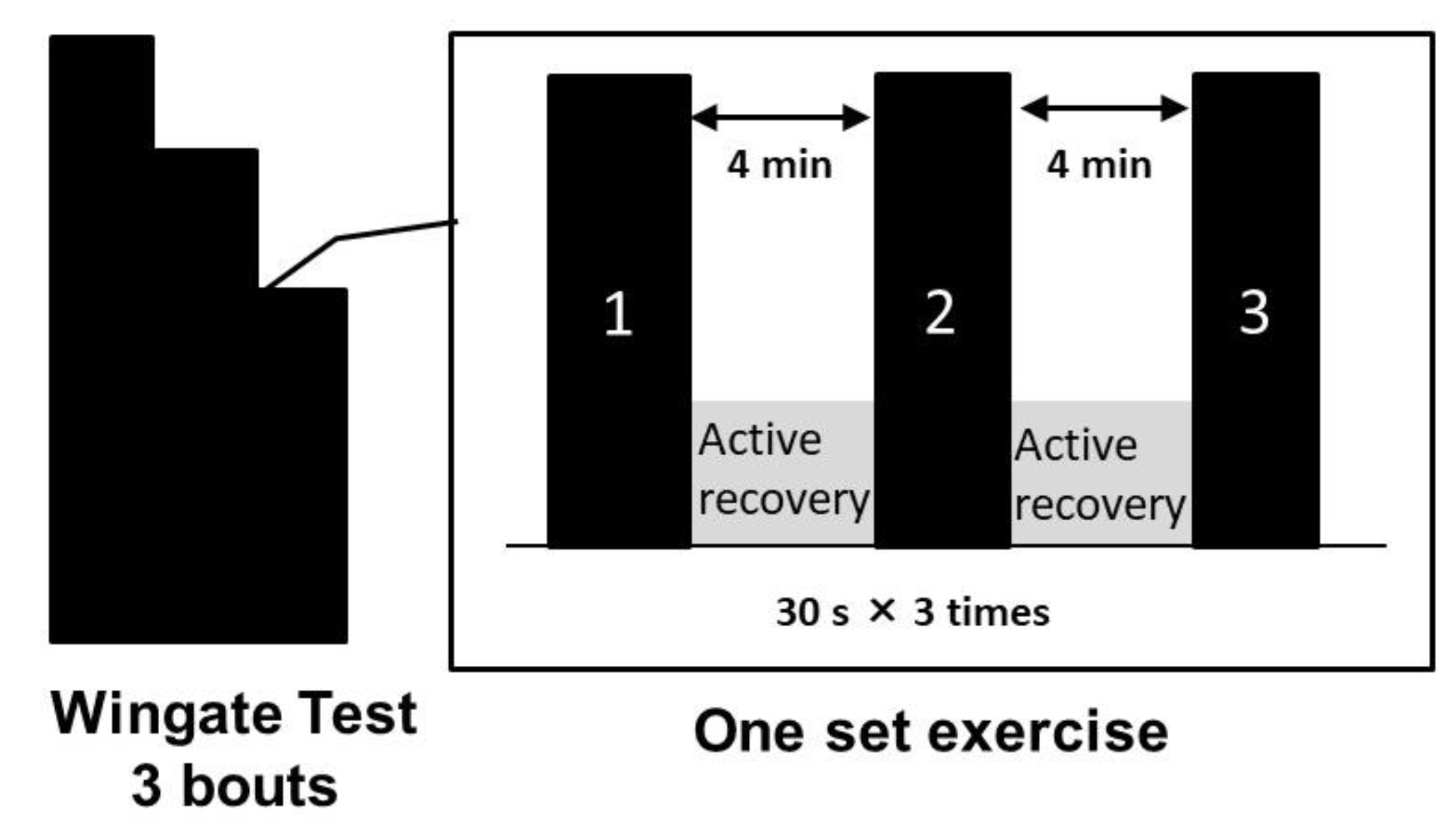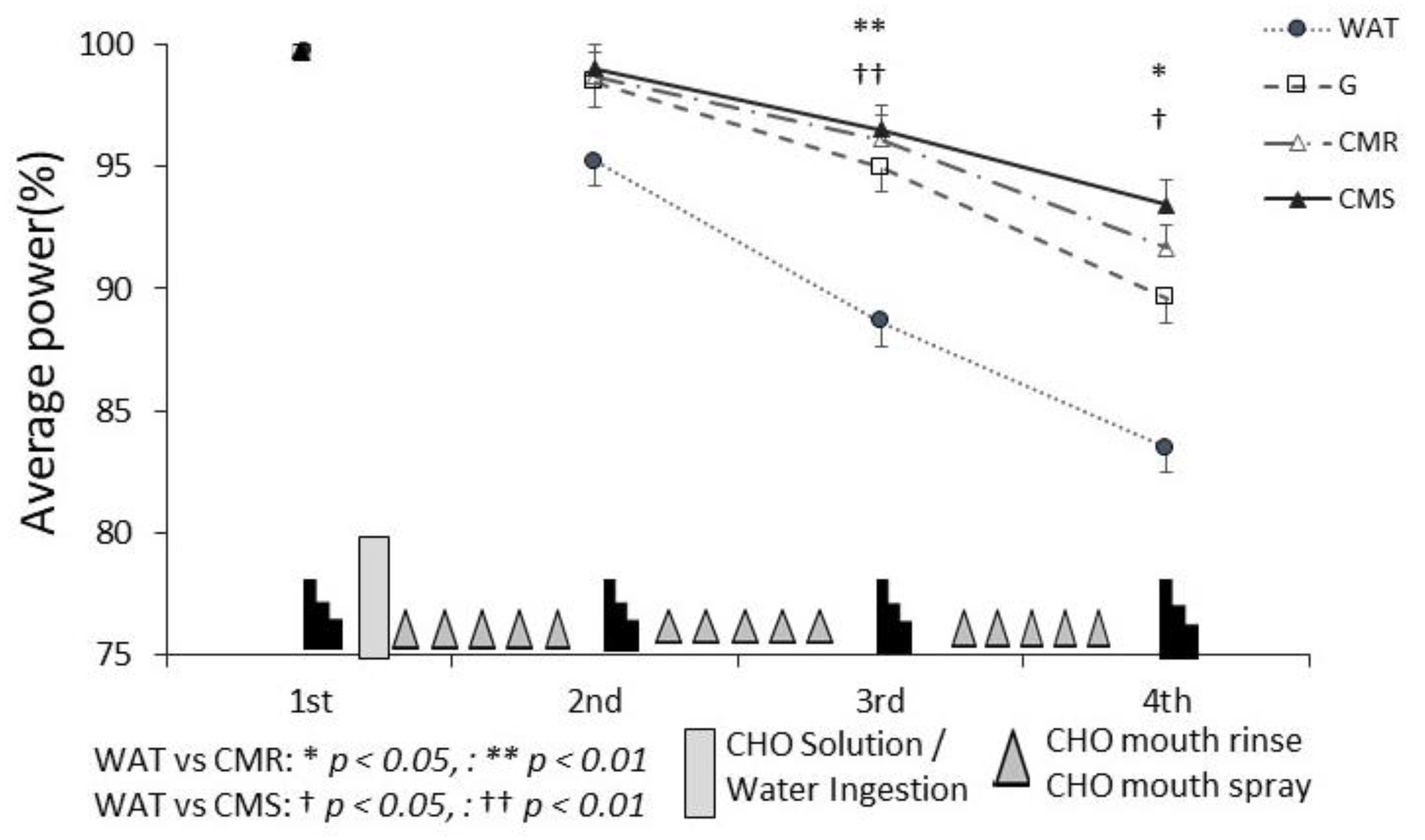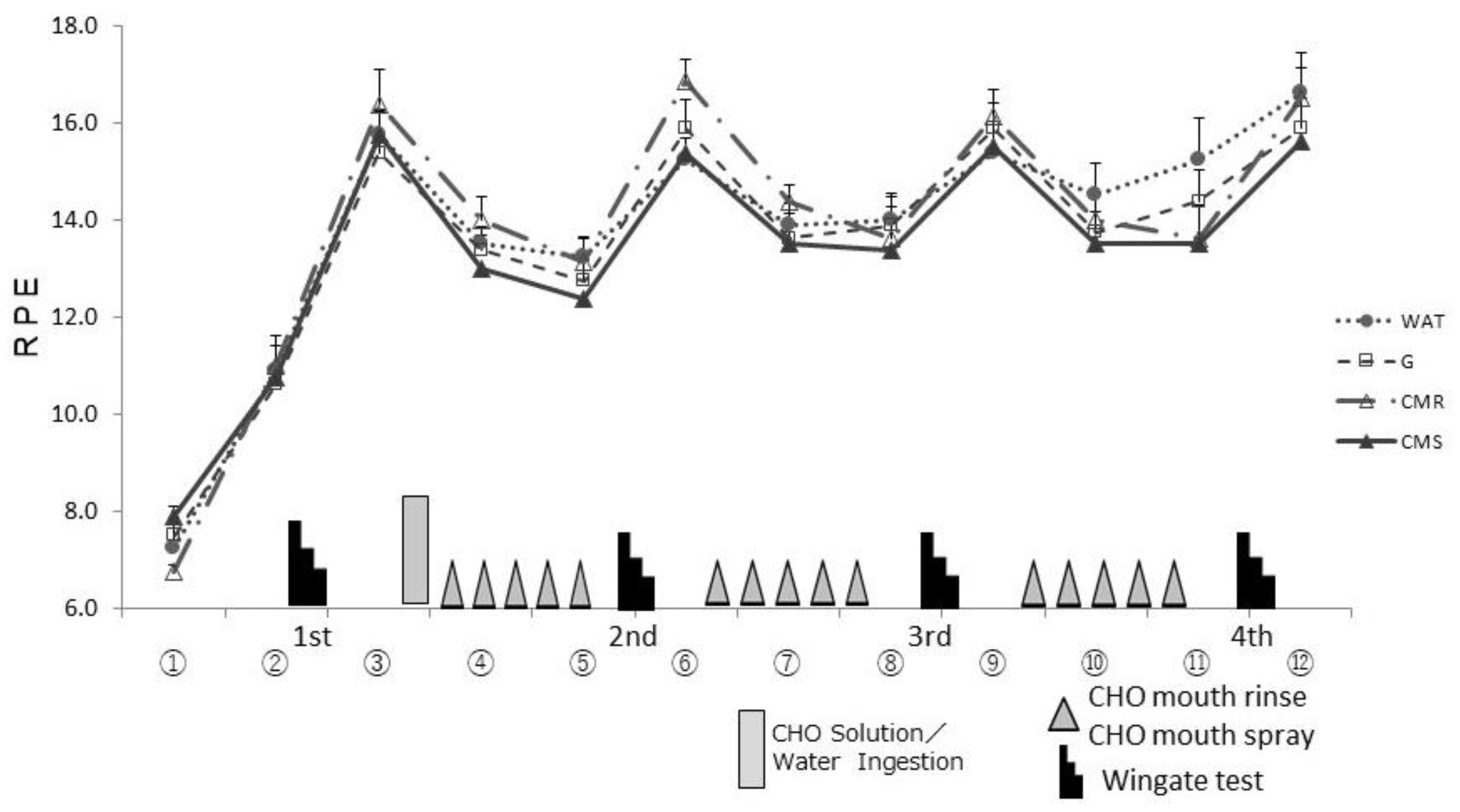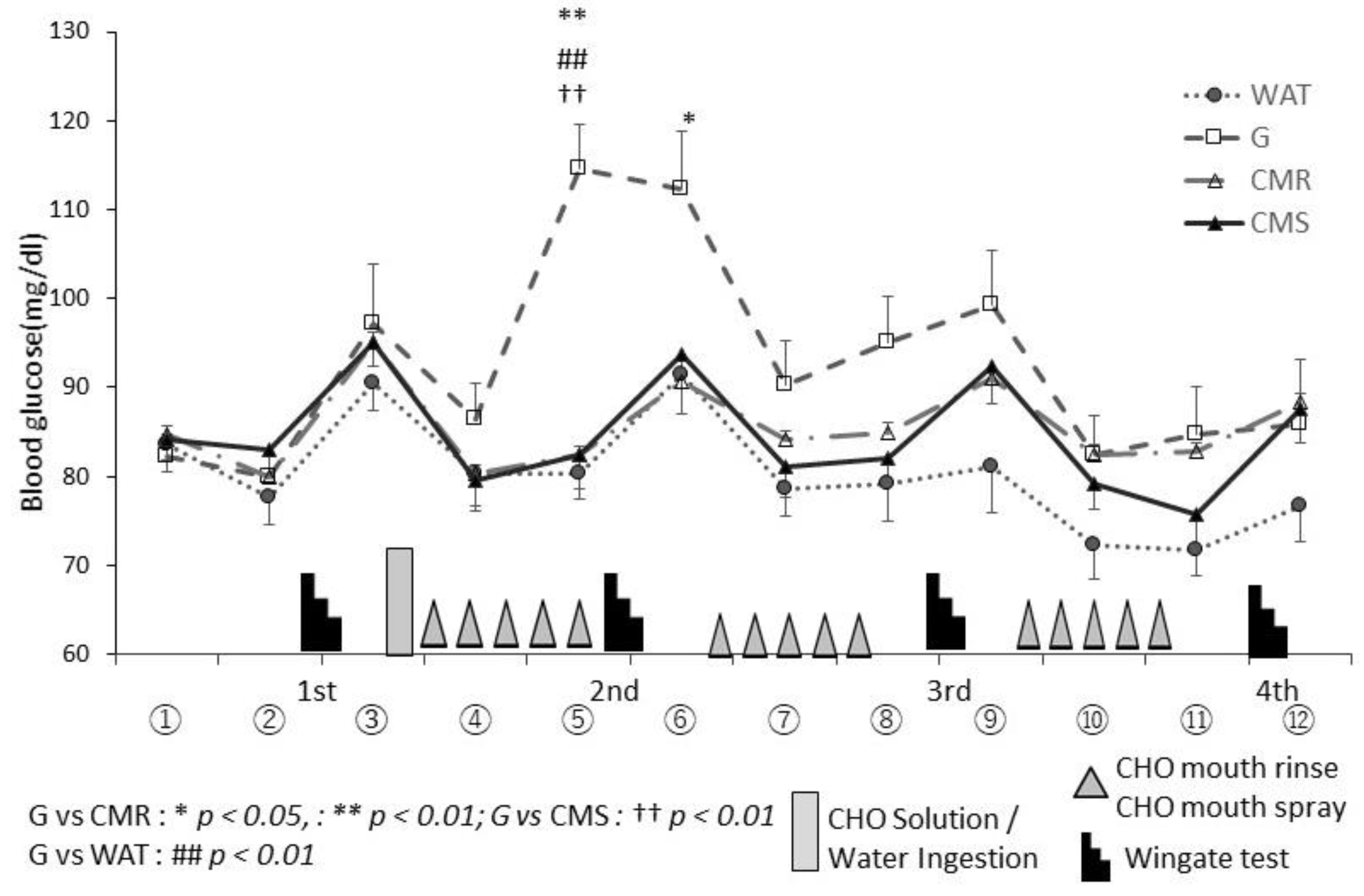Carbohydrate Mouth Rinse and Spray Improve Prolonged Exercise Performance in Recreationally Trained Male College Students
Abstract
:1. Introduction
2. Materials and Methods
2.1. Participants
2.2. Preliminary Test
2.3. Experimental Design
2.3.1. Wadazumi Protocol
2.3.2. Wingate Test
2.4. Carbohybrate Solution, Mouth Rinse and Mouth Spray
2.5. Assessment of Exercise Performance
2.5.1. Exercise Performance
2.5.2. Ratings of Perceived Exertion (RPE)
2.5.3. Blood Glucose Levels
2.6. Statistical Analysis
2.7. Ethics
3. Results
3.1. Average Power Value for Each Set of the Wingate Tests
3.2. RPE
3.3. Blood Glucose Levels
4. Discussion
4.1. Effects of Mouth Rinse on Ultra-High Intensity Intermittent Exercise
4.2. Relationship between CHO Mouth Rinse and Motor Fatigue
4.3. Prospects for CHO Mouth Spray
4.4. Limitations
5. Conclusions
Author Contributions
Funding
Institutional Review Board Statement
Informed Consent Statement
Data Availability Statement
Conflicts of Interest
References
- Coyle, E.F.; Coggan, A.R.; Hemmert, M.K.; Ivy, J.L. Muscle glycogen utilization during prolonged strenuous exercise when fed carbohydrate. J. Appl. Physiol. 1986, 61, 165–172. [Google Scholar] [CrossRef]
- Jeukendrup, A. A Step Towards Personalized Sports Nutrition: Carbohydrate Intake During Exercise. Sports Med. 2014, 44, 25–33. [Google Scholar] [CrossRef] [PubMed] [Green Version]
- Carter, J.M.; Jeukendrup, A.E.; Jones, D.A. The Effect of Carbohydrate Mouth Rinse on 1-h Cycle Time Trial Performance. Med. Sci. Sports Exerc. 2004, 36, 2107–2111. [Google Scholar] [CrossRef] [PubMed]
- Carter, J.M.; Jeukendrup, A.E.; Mann, C.H.; Jones, D.A. The Effect of Glucose Infusion on Glucose Kinetics during a 1-h Time Trial. Med. Sci. Sports Exerc. 2004, 36, 1543–1550. [Google Scholar] [CrossRef] [PubMed]
- Chambers, E.S.; Bridge, M.; Jones, D.A. Carbohydrate sensing in the human mouth: Effects on exercise performance and brain activity. J. Physiol. 2009, 587, 1779–1794. [Google Scholar] [CrossRef]
- Kinnamon, S.C. Taste receptor signalling—From tongues to lungs. Acta Physiol. 2011, 204, 158–168. [Google Scholar] [CrossRef]
- Ferreira, A.M.J.; Farias-Junior, L.F.; Mota, T.A.A.; Elsangedy, H.M.; Marcadenti, A.; Lemos, T.M.A.M.; Okano, A.H.; Fayh, A.P.T. The effect of carbohydrate mouth rinse on performance, biochemical and psychophysiological variables during a cycling time trial: A crossover randomized trial. J. Int. Soc. Sports Nutr. 2018, 15, 1–9. [Google Scholar] [CrossRef]
- Lane, S.C.; Bird, S.R.; Burke, L.M.; Hawley, J.A. Effect of a carbohydrate mouth rinse on simulated cycling time-trial performance commenced in a fed or fasted state. Appl. Physiol. Nutr. Metab. 2013, 38, 134–139. [Google Scholar] [CrossRef]
- Pottier, A.; Bouckaert, J.; Gilis, W.; Roels, T.; Derave, W. Mouth rinse but not ingestion of a carbohydrate solution improves 1-h cycle time trial performance. Scand. J. Med. Sci. Sports 2010, 20, 105–111. [Google Scholar] [CrossRef]
- Rollo, I.; Williams, C.; Gant, N.; Nute, M. The Influence of Carbohydrate Mouth Rinse on Self-Selected Speeds during a 30-min Treadmill Run. Int. J. Sport Nutr. Exerc. Metab. 2008, 18, 585–600. [Google Scholar] [CrossRef]
- Jeukendrup, A.E.; Rollo, I.; Carter, J.M. Carbohydrate mouth rinse: Performance effects and mechanisms. Sports Sci. Exch. 2013, 26, 1–8. [Google Scholar]
- Gant, N.; Stinear, C.; Byblow, W. Carbohydrate in the mouth immediately facilitates motor output. Brain Res. 2010, 1350, 151–158. [Google Scholar] [CrossRef]
- Hirata, Y.; Wadazumi, T.; Hamada, N.; Shirai, A.; Watanabe, H. The effect of carbohydrate mouth rinse in isometric hand grip performance. Jpn. J. Phys. Fit. Sports Med. 2021, 70, 269–276. [Google Scholar] [CrossRef]
- Simpson, G.W.; Pritchett, R.; O’Neal, E.; Hoskins, G.; Pritchett, K. Carbohydrate Mouth Rinse Improves Relative Mean Power During Multiple Sprint Performance. Int. J. Exerc. Sci. 2018, 11, 754–763. [Google Scholar]
- Rollo, I.; Homewood, G.; Williams, C.; Carter, J.; Goosey-Tolfrey, V.L. The Influence of Carbohydrate Mouth Rinse on Self-Selected Intermittent Running Performance. Int. J. Sport Nutr. Exerc. Metab. 2015, 25, 550–558. [Google Scholar] [CrossRef] [Green Version]
- Karayigit, R.; Eser, M.C.; Gur, F.; Sari, C.; Cepicka, L.; Gabrys, T. Carbohydrate Mouth Rinse Increases High but Not Low Intensity Repetitions to Failure in Resistance-Trained Males. Nutrients 2022, 14, 875. [Google Scholar] [CrossRef]
- Pomportes, L.; Brisswalter, J. Carbohydrate mouth rinse effects on physical and cognitive performance: Benefits and limitations in sports. Sci. Sports 2020, 35, 200–206. [Google Scholar] [CrossRef]
- Chong, E.; Guelfi, K.; Fournier, P. Effect of a carbohydrate mouth rinse on maximal sprint performance in competitive male cyclists. J. Sci. Med. Sport 2011, 14, 162–167. [Google Scholar] [CrossRef]
- Fares, E.-J.M.; Kayser, B. Carbohydrate Mouth Rinse Effects on Exercise Capacity in Pre- and Postprandial States. J. Nutr. Metab. 2011, 2011, 1–6. [Google Scholar] [CrossRef] [Green Version]
- Gam, S.; Guelfi, K.; Fournier, P.A. Opposition of Carbohydrate in a Mouth-Rinse Solution to the Detrimental Effect of Mouth Rinsing During Cycling Time Trials. Int. J. Sport Nutr. Exerc. Metab. 2013, 23, 48–56. [Google Scholar] [CrossRef]
- Wadazumi, T.; Watanabe, K.; Watanabe, H.; Yokoyama, H.; Hongu, N.; Arai, N. Effects of a Single Ingestion of Trehalose during Prolonged Exercise. Sports 2019, 7, 100. [Google Scholar] [CrossRef] [PubMed] [Green Version]
- Hamada, N.; Wadazumi, T.; Hirata, Y.; Kuriyama, M.; Watanabe, K.; Watanabe, H.; Hongu, N.; Arai, N. Single Ingestion of Trehalose Enhances Prolonged Exercise Performance by Effective Use of Glucose and Lipid in Healthy Men. Nutrients 2021, 13, 1439. [Google Scholar] [CrossRef] [PubMed]
- Borg, G.A. Psychophysical bases of perceived exertion. Med. Sci. Sports Exerc. 1982, 14, 377–381. [Google Scholar] [CrossRef] [PubMed]
- Dorling, J.L.; Earnest, C.P. Effect of carbohydrate mouth rinsing on multiple sprint performance. J. Int. Soc. Sports Nutr. 2013, 10, 41. [Google Scholar] [CrossRef] [PubMed] [Green Version]
- Turner, C.E.; Byblow, W.D.; Stinear, C.M.; Gant, N. Carbohydrate in the mouth enhances activation of brain circuitry involved in motor performance and sensory perception. Appetite 2014, 80, 212–219. [Google Scholar] [CrossRef]
- Allen, D.G.; Lamb, G.D.; Westerblad, H. Skeletal Muscle Fatigue: Cellular Mechanisms. Physiol. Rev. 2008, 88, 287–332. [Google Scholar] [CrossRef] [Green Version]
- Nybo, L. CNS Fatigue and Prolonged Exercise: Effect of Glucose Supplementation. Med. Sci. Sports Exerc. 2003, 35, 589–594. [Google Scholar] [CrossRef]
- Noakes, T.D.O. Fatigue is a Brain-Derived Emotion that Regulates the Exercise Behavior to Ensure the Protection of Whole Body Homeostasis. Front. Physiol. 2012, 3, 82. [Google Scholar] [CrossRef] [Green Version]
- Nybo, L. Hyperthermia and fatigue. J. Appl. Physiol. 2008, 104, 871–878. [Google Scholar] [CrossRef] [Green Version]
- Rolls, E.T. Sensory processing in the brain related to the control of food intake. Proc. Nutr. Soc. 2007, 66, 96–112. [Google Scholar] [CrossRef] [Green Version]
- Rolls, E.T. The Orbitofrontal Cortex and Reward. Cereb. Cortex 2000, 10, 284–294. [Google Scholar] [CrossRef]
- Hagger, M.S.; Chatzisarantis, N. The Sweet Taste of Success: The presence of glucose in the oral cavity moderates the depletion of self-control resources. Pers. Soc. Psychol. Bull. 2013, 39, 28–42. [Google Scholar] [CrossRef] [Green Version]
- Molden, D.C.; Hui, C.M.; Scholer, A.A.; Meier, B.P.; Noreen, E.E.; D’Agostino, P.R.; Martin, V. Motivational Versus Metabolic Effects of Carbohydrates on Self-Control. Psychol. Sci. 2012, 23, 1137–1144. [Google Scholar] [CrossRef]
- Sanders, M.A.; Shirk, S.D.; Burgin, C.J.; Martin, L.L. The Gargle Effect: Rinsing the mouth with glucose enhances self-control. Psychol. Sci. 2012, 23, 1470–1472. [Google Scholar] [CrossRef]
- Decimoni, L.S.; Curty, V.M.; Almeida, L.; Koch, A.J.; Willardson, J.M.; Machado, M. Carbohydrate mouth rinsing improves resistance training session performance. Int. J. Sports Sci. Coach. 2018, 13, 804–809. [Google Scholar] [CrossRef]
- Jensen, M.; Stellingwerff, T.; Klimstra, M. Carbohydrate Mouth Rinse Counters Fatigue Related Strength Reduction. Int. J. Sport Nutr. Exerc. Metab. 2015, 25, 252–261. [Google Scholar] [CrossRef]






| Age (Years) | Height (cm) | Weight (kg) | Fat (%) | 40% VO2peak (mL/min) | Load (40% VO2peak) (W) | |
|---|---|---|---|---|---|---|
| Mean | 22.3 | 171.9 | 67.0 | 21.1 | 1212.0 | 103.2 |
| SD | 1.3 | 4.7 | 6.63 | 3.15 | 112.5 | 12.69 |
Publisher’s Note: MDPI stays neutral with regard to jurisdictional claims in published maps and institutional affiliations. |
© 2022 by the authors. Licensee MDPI, Basel, Switzerland. This article is an open access article distributed under the terms and conditions of the Creative Commons Attribution (CC BY) license (https://creativecommons.org/licenses/by/4.0/).
Share and Cite
Shirai, A.; Wadazumi, T.; Hirata, Y.; Hamada, N.; Hongu, N. Carbohydrate Mouth Rinse and Spray Improve Prolonged Exercise Performance in Recreationally Trained Male College Students. Sports 2022, 10, 51. https://doi.org/10.3390/sports10040051
Shirai A, Wadazumi T, Hirata Y, Hamada N, Hongu N. Carbohydrate Mouth Rinse and Spray Improve Prolonged Exercise Performance in Recreationally Trained Male College Students. Sports. 2022; 10(4):51. https://doi.org/10.3390/sports10040051
Chicago/Turabian StyleShirai, Asako, Tsuyoshi Wadazumi, Yoko Hirata, Naomi Hamada, and Nobuko Hongu. 2022. "Carbohydrate Mouth Rinse and Spray Improve Prolonged Exercise Performance in Recreationally Trained Male College Students" Sports 10, no. 4: 51. https://doi.org/10.3390/sports10040051






